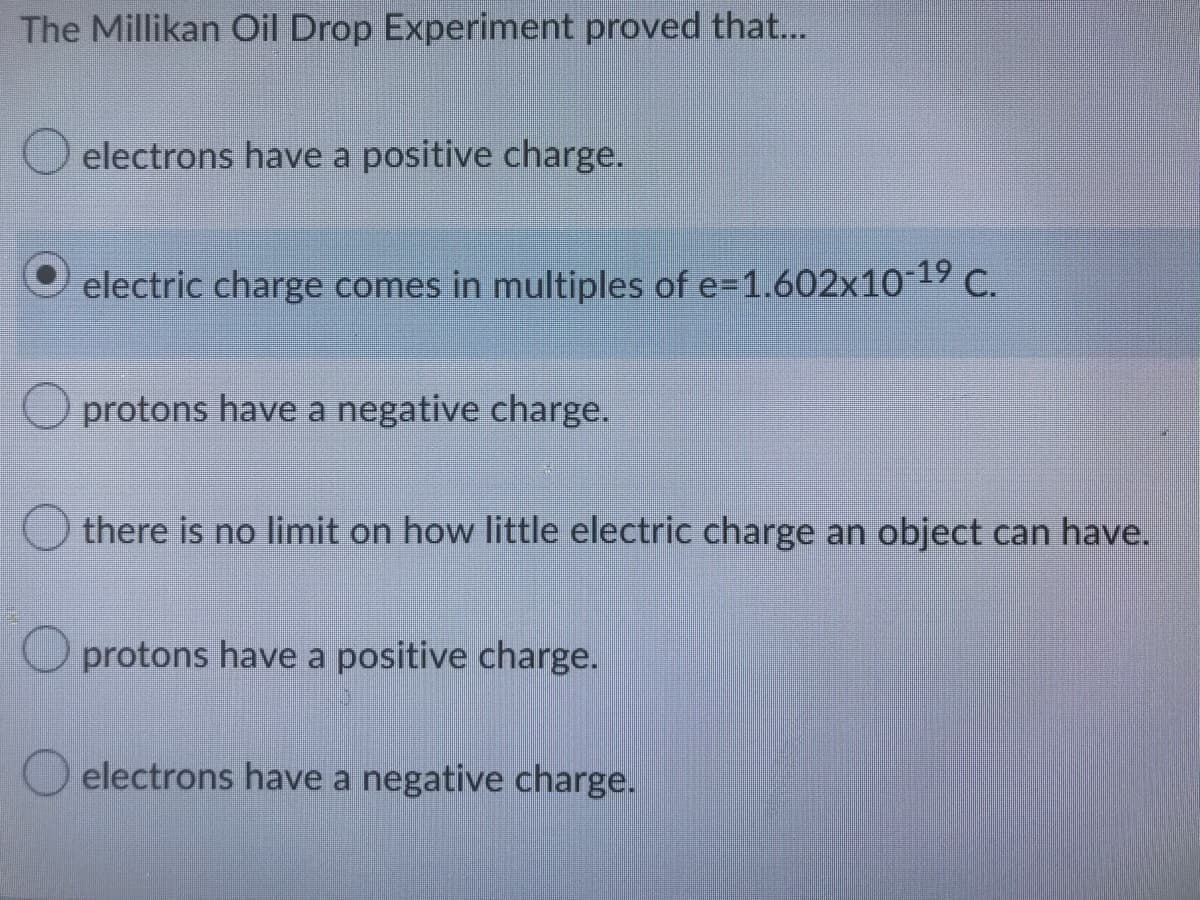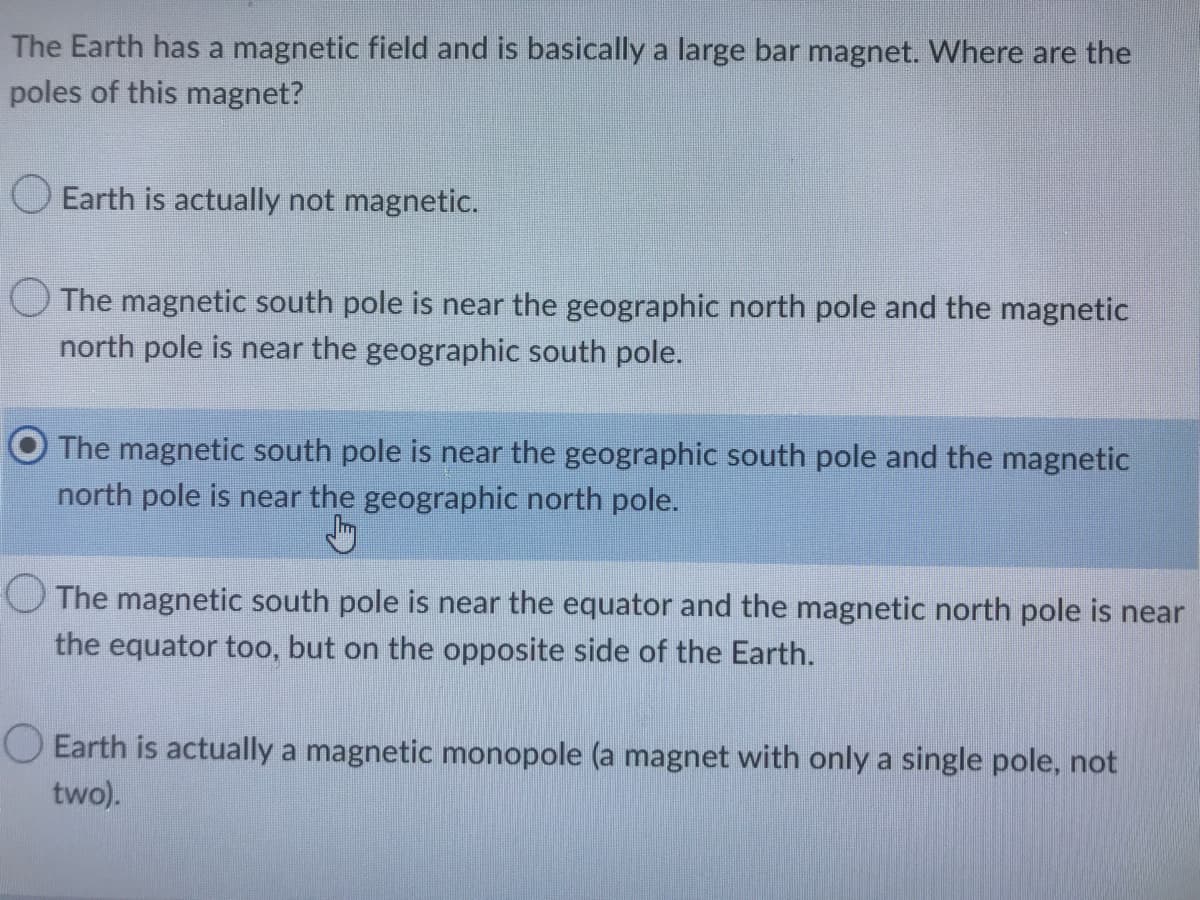The Millikan Oil Drop Experiment proved that... electrons have a positive charge. electric charge comes in multiples of e=1.602x10-19 C. protons have a negative charge. there is no limit on how little electric charge an object can have. protons have a positive charge. electrons have a negative charge.
The Millikan Oil Drop Experiment proved that... electrons have a positive charge. electric charge comes in multiples of e=1.602x10-19 C. protons have a negative charge. there is no limit on how little electric charge an object can have. protons have a positive charge. electrons have a negative charge.
College Physics
1st Edition
ISBN:9781938168000
Author:Paul Peter Urone, Roger Hinrichs
Publisher:Paul Peter Urone, Roger Hinrichs
Chapter30: Atomic Physics
Section: Chapter Questions
Problem 5PE: In Millikan's oil-drop experiment, one looks at a small oil drop held motionless between two plates....
Related questions
Question
Please check if these questions are correct

Transcribed Image Text:The Millikan Oil Drop Experiment proved that...
electrons have a positive charge.
electric charge comes in multiples of e-1.602x10-1⁹ C.
protons have a negative charge.
there is no limit on how little electric charge an object can have.
protons have a positive charge.
electrons have a negative charge.

Transcribed Image Text:The Earth has a magnetic field and is basically a large bar magnet. Where are the
poles of this magnet?
Earth is actually not magnetic.
The magnetic south pole is near the geographic north pole and the magnetic
north pole is near the geographic south pole.
The magnetic south pole is near the geographic south pole and the magnetic
north pole is near the geographic north pole.
Jay
The magnetic south pole is near the equator and the magnetic north pole is near
the equator too, but on the opposite side of the Earth.
O Earth is actually a magnetic monopole (a magnet with only a single pole, not
two).
Expert Solution
This question has been solved!
Explore an expertly crafted, step-by-step solution for a thorough understanding of key concepts.
Step by step
Solved in 2 steps

Knowledge Booster
Learn more about
Need a deep-dive on the concept behind this application? Look no further. Learn more about this topic, physics and related others by exploring similar questions and additional content below.Recommended textbooks for you

College Physics
Physics
ISBN:
9781938168000
Author:
Paul Peter Urone, Roger Hinrichs
Publisher:
OpenStax College

Physics for Scientists and Engineers: Foundations…
Physics
ISBN:
9781133939146
Author:
Katz, Debora M.
Publisher:
Cengage Learning

University Physics Volume 3
Physics
ISBN:
9781938168185
Author:
William Moebs, Jeff Sanny
Publisher:
OpenStax

College Physics
Physics
ISBN:
9781938168000
Author:
Paul Peter Urone, Roger Hinrichs
Publisher:
OpenStax College

Physics for Scientists and Engineers: Foundations…
Physics
ISBN:
9781133939146
Author:
Katz, Debora M.
Publisher:
Cengage Learning

University Physics Volume 3
Physics
ISBN:
9781938168185
Author:
William Moebs, Jeff Sanny
Publisher:
OpenStax

Principles of Physics: A Calculus-Based Text
Physics
ISBN:
9781133104261
Author:
Raymond A. Serway, John W. Jewett
Publisher:
Cengage Learning

College Physics
Physics
ISBN:
9781285737027
Author:
Raymond A. Serway, Chris Vuille
Publisher:
Cengage Learning

An Introduction to Physical Science
Physics
ISBN:
9781305079137
Author:
James Shipman, Jerry D. Wilson, Charles A. Higgins, Omar Torres
Publisher:
Cengage Learning